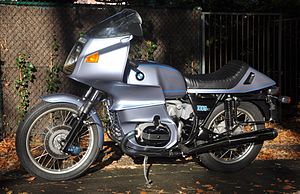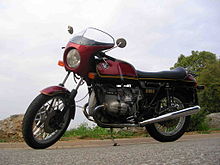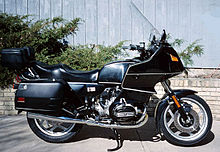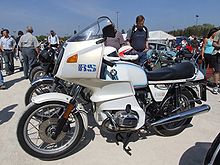BMW R 100
| BMW | |
|---|---|
 1977 BMW R 100 RS |
|
| R 100 | |
| Manufacturer | BMW |
| class | motorcycle |
| design type | Tourer |
| Motor data | |
BMW R 100 without and with the additions T, S, CS, RS, RS Classic , RT, RT Classic , R and GS is one of BMW term used for various motorcycle series , all of a two-cylinder four-stroke - Boxer engine with approximately 1000 cc Have cubic capacity. The name was used from 1976 to 1996 for different models.
This article also covers the other models in the / 7 series with a smaller displacement ( R 60/7 , R 75/7 and R 80/7 ). The predecessors were the / 6 models .
First (/ 7) and second series
When the new series with the collective name "Strich-Sieben" was introduced, there were the model variants BMW R 100 RS (51 kW / 70 PS), R 100 S (only 48 kW / 65 PS), R 100 (44 kW / 60 PS) , R 75/7 (37 kW / 50 PS) and R 60/7 (30 kW / 40 PS). Internal designation was type 247.
The R 100 RS was the first motorcycle with a frame-mounted full fairing as standard. In addition, this cladding differed significantly from the customary, common claddings from various suppliers. The design comes from Hans A. Muth. Their weight is 9.5 kg.
The R 100 CS ( C lassic S port) was associated with a top speed of over 200 km / h of the fastest production motorcycle in the world.
Brakes
The R-100 models received a double disc brake system in the front wheel. In the years of construction up to 1980 they got a swiveling calliper brake from ATE with a master cylinder under the tank operated by a cable. From model year 1981, the models received other fork tubes with Brembo fixed caliper brakes. The hand brake cylinder came to the right end of the handlebar. With the introduction of the Monolever models in 1986, the Brembo fixed caliper brakes were fitted to the front of the fork tubes. At the rear it was a full-hub inner-jaw drum brake (simplex). From the 1978 model onwards, the R 100 RS and the RT received a disc brake with a fixed Brembo calliper on the rear wheel, and from the 1986 model year again the drum brake with linkage actuation.
bikes
The top-of-the-range models, which were new at the time, initially had wire-spoke wheels like their predecessors, but soon had filigree cast aluminum wheels. But these bikes were not free from defects. There were individual cases of broken spokes on the first cast front wheels, which is why these wheels were subsequently exchanged for a reinforced version on all vehicles delivered.
drive
- Two-cylinder boxer engine installed lengthways with overhead valves operated by push rods .
- Drive of the camshaft below via timing chain . Initially duplex, later simplex roller chain with spring-loaded chain tensioner .
- Single-disc dry clutch operated by a cable.
- 5-speed gearbox, optionally with an additional kick starter . Power transmission via cardan shaft and bevel gearbox to the rear wheel.
Carburetor
All models had two carburetors from the Nuremberg company Bing : the R60 / 7 had slide carburetors , all other machines had constant pressure carburetors .
landing gear
The telescopic fork on the front wheel has sliding tubes with a diameter of 50 mm without bellows. Rear up to model year 1984 two-sided swing arm with two shock absorbers, from model year 1986 the single-sided swing arm, also known as monolever, was used.
ignition
Up to model year 1980 a contact-controlled high-voltage capacitor ignition, initially open, later in a tin can, was installed. From model year 1980, a Hall sensor took over the function of the interrupter.
The R 100 S (later CS) has the same handlebar-mounted half-shell fairing as the predecessor model R 90 S and a rear apron.
Later three more machines came in the same series, the R 80/7 as a slightly enlarged displacement of the R 75/7, then a touring model (R 100 RT), essentially identical in construction to the R 100 RS, but with a modified upper cover and higher Windscreen, and the R 100 CS, an S.
Technical specifications
| model | cylinder | Bore × stroke (mm) | Displacement (cm³) | Power (hp at 1 / min) | construction time | number of pieces |
|---|---|---|---|---|---|---|
| R 60/7 | 2 | 73.5 x 70.6 | 599 | 40/6400 | 1976-1980 | 11,163 |
| R 75/7 | 2 | 82 x 70.6 | 745 | 50/6200 | 1976-1977 | 6.264 |
| R 80/7 | 2 | 84.8 x 70.6 | 797 | 50/7250 | 1977-1983 | 17,703 |
| R 100/7 | 2 | 94 x 70.6 | 980 | 60/6500 | 1976-1988 | 12,029 |
| R 100 S | 2 | 94 x 70.6 | 980 | 66/6600 | 1976-1988 | 9,657 |
| R 100 RS | 2 | 94 x 70.6 | 980 | 70/7250 | 1976-1984 | 33,648 |
| R 100 RT | 2 | 94 x 70.6 | 980 | 70/7250 | 1978-1984 | 18,015 |
| R 100 T | 2 | 94 x 70.6 | 980 | 66/7250 | 1978-1980 | 5,643 |
| R 100 | 2 | 94 x 70.6 | 980 | 66/7000 | 1980-1984 | 10.111 |
| R 100 CS | 2 | 94 x 70.6 | 980 | 70/7000 | 1980-1984 | 4.038 |
Pause and restart
In the 1980s, BMW wanted to promote the water-cooled K75 and K100 models for environmental and marketing reasons and to catch up with the technical lead of the Japanese motorcycle industry. To do this, they wanted to give up the production of the "old" two-valve box models. After this decision had led to protests from customers and dealers, BMW again delivered R-100 models, but with modified, weaker HP, but improved engines with 44 kW (60 HP). Then an 800 version with 37 kW (50 PS) was added. At the same time, in 1980 the enduro model R 80 G / S with chassis modification (single-arm swing arm rear) and simpler equipment (without rev counter) was released, which was replaced by the GS model (without slash) in model year 88. In 1981, 2,333 units were sold in West Germany.
From 1985 the street versions were also equipped with a single-sided swing arm. Many small details on the engine have been improved. From 1988 the Paralever was introduced on the two-valve engine, first in the GS models R 80 GS and R 100 GS, later also in the street versions R 80 R and R 100 R. The Paralever intercepts the erection moments of the load reactions on the cardan and thus eliminates this Installation moment of the older models. This ended the justification for the “ rubber cow ” slogan that motorcycle journalist Ernst Leverkus , known as “Klacks”, once coined.
Trivia
Since the engines and chassis of the two-valve boxer are largely compatible with each other, a certain degree of caution is advisable when buying. It must be checked whether a motorcycle is in its original condition. Often, power-modified engines were installed across the entire range of power, from artificially throttled 20-hp and 27-hp engines of various cubic capacities to racing-revised 1000s with far more than 59 kW (80 hp). The extreme conversions are old / 5 or / 6 models that got the latest Paralever chassis after a frame damage and have an engine from experienced tuners like Fallert with over 85 hp. Such sports conversions were also used for about two decades in the increasingly popular international endurance races of the "Battle of Twins" series.
See also
literature
- Hans-Jürgen Schneider: BMW R 45 - R 100 RS from year of construction 1976: all models with two-cylinder boxer engine; Technology, maintenance, repairs BLV Auto- und Motorradpraxis, Munich Vienna Zurich 1984, ISBN 3-405-12908-7 .
- Don Morley, Mick Woollett: BMW. Heel Verlag, Königswinter 1994. ISBN 3-89365-402-X .
- Hans-Joachim Mai: 1000 tricks for fast BMWs. 11th edition 1988, Motorbuch-Verlag, Stuttgart.
- Andy Schwietzer, Werner R. Reiss: BMW Boxer all from / 5: BMW two-valve from 1969–1985. 1st edition. Bodensteiner-Verlag, Wallmoden 2006, ISBN 3-9806631-4-0 .
Web links
Individual evidence
- ↑ motorradonline.de from September 17, 2015, future is past , accessed on October 1, 2019.
- ↑ Stefan Knittel: BMW Motorcycles . Gerlingen 1984, ISBN 3-88350-152-2 .




